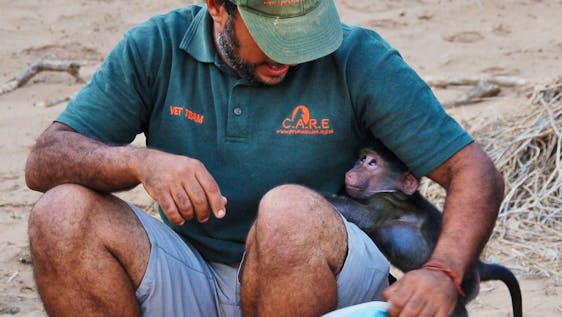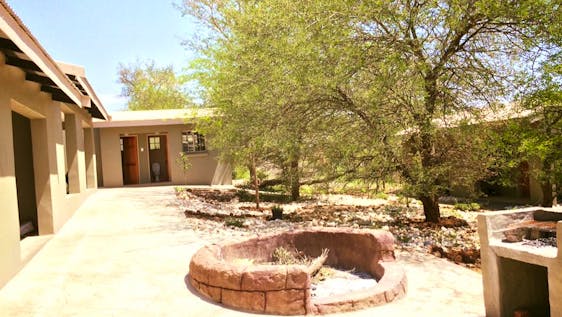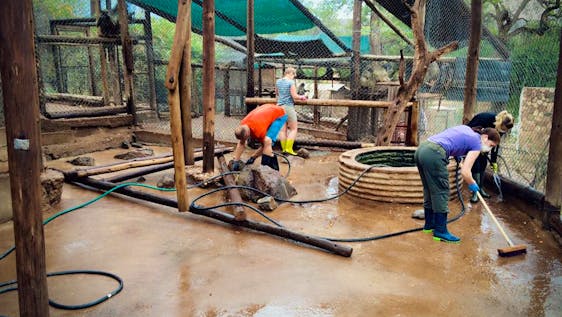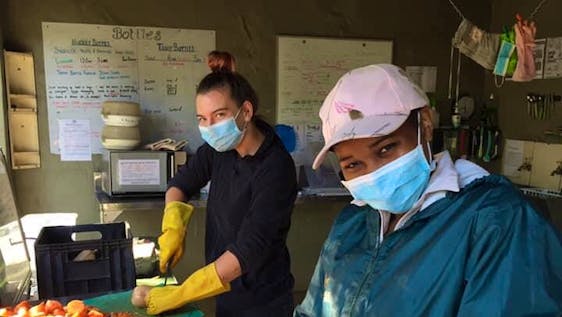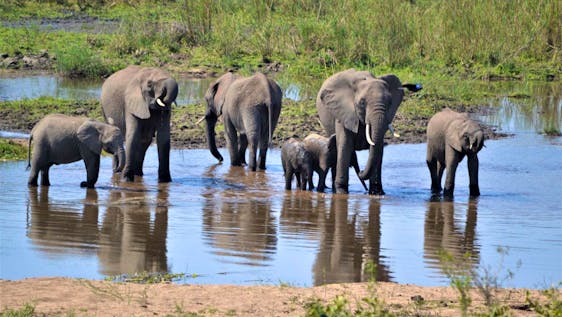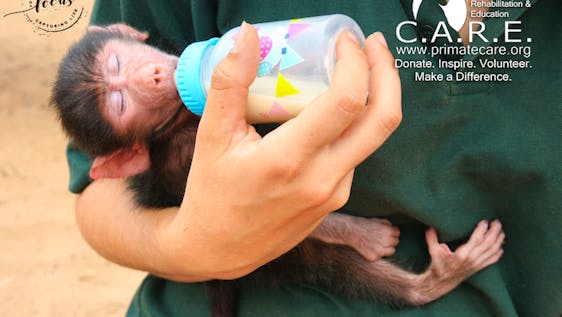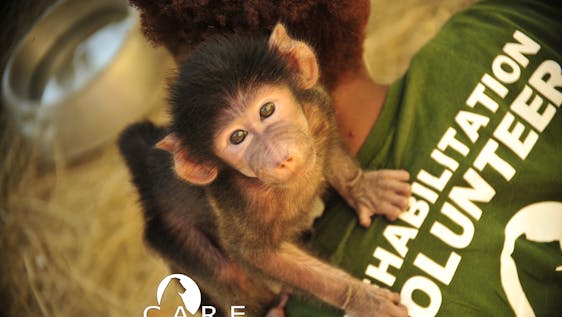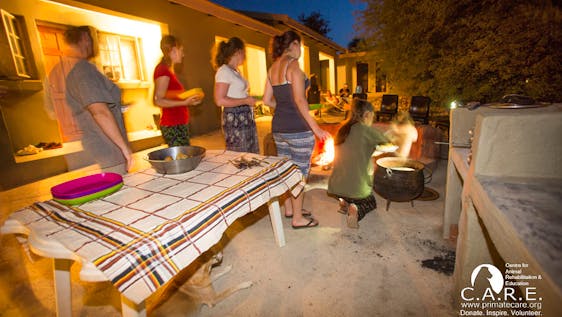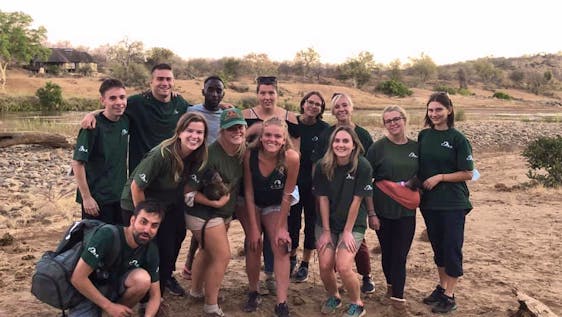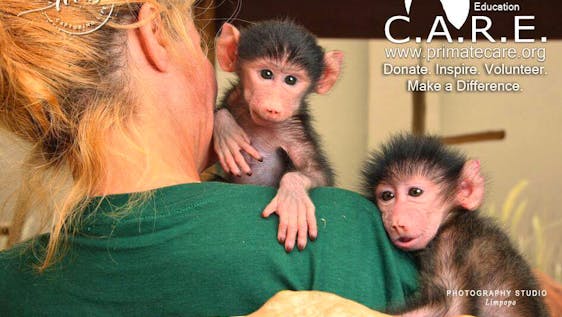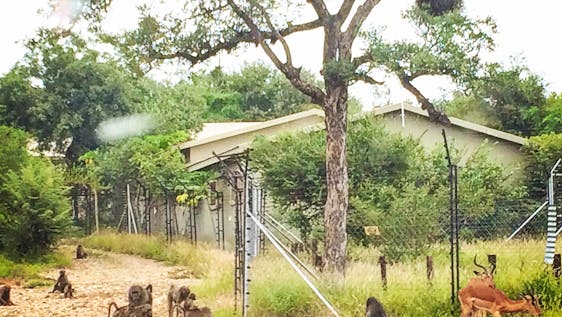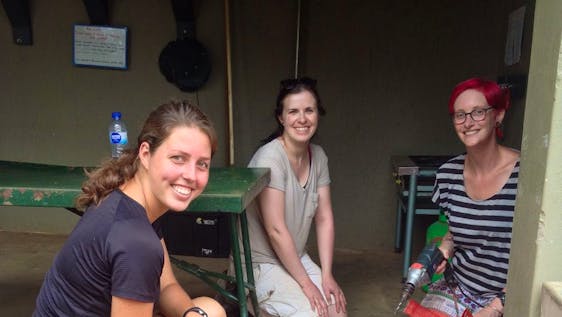With purpose built facilities we are committed to the rescue, care, rehabilitation, release and protection of wild animals, no animal in need is ever turned away. We rely solely on the generosity of caring individuals to fund the centre, and also volunteers to help us run the centre too.
Founded in 1989 by the late Rita Miljo as a refuge for a handful of baboons whom had been subjected to abuse by humans, C.A.R.E. has since grown into the largest rehabilitation centre for chacma baboons worldwide.
Based on the edge of the Kruger National Park in South Africa, C.A.R.E. is the perfect setting for wildlife rehabilitation and volunteers come from all over the world to help care for the baboons. We currently house around 450 baboons and are one of the only sanctuaries that have experience for giving refuge to orphaned and injured baboons in South Africa. We have an extremely high success rate of releasing hand-reared, fully formed troops back into the wild.
There was a devastating fire in 2012 which destroyed the main facilities and sadly Rita and three baboons died. Since then, the team have been dedicated to continue Rita's legacy. New facilities have been constructed with more are underway. A new Veterinary Clinic funded by IPPL and the Boda Trust was built in 2014, along with a new nursery, baboon kitchen and soon to be completed Education Centre.
The team have also released three troops of baboons since along with many males as 'dispersing males' which have joined chosen wild troops.
The rehabilitation methods continue to be refined, meaning orphan baby baboons are quickly bonded to an adult baboon female which acts as the surrogate mother, this minimizes time needing to be spent in captivity.
It is C.A.R.E.’s priority to help any animal in need and we have a wide network of friends and colleagues within animal rehabilitation which usually means we can offer advice and recommend suitable facilities for the housing and rehabilitation of all South Africa’s wildlife.
C.A.R.E.’s main focus is the rehabilitation of chacma baboons and we will respond to calls at any hour of the day or night. Most of our rescue cases involve orphan babies which have been the result of their mother being killed by hunting, poisoning, traffic accidents and many more heartbreaking incidents. We rescue baboons of all ages and integrate them into troops from all backgrounds such as the pet trade, research laboratories and from witch doctors. We can offer help and guidance with possible solutions to ‘problem baboons’.
Most of the baboons which we rescue have been subject to physical or emotional abuse by humans and arrive often traumatised and dehydrated.
The success of the release of wildlife back into their natural habitat goes hand in hand with appropriate species-specific rehabilitation.
C.A.R.E. has been rehabilitating wildlife since 1989 and Rita Mijo, the founder of C.A.R.E. was the first person in the world to suceed in releasing a cohesive troop of hand-reared primates back into the wild.
Our main focus for any baboon which arrives at C.A.R.E. is to rehabilitate baboons into viable troops and release the self-sustaining troops back into their natural habitat.
C.A.R.E. specialises in the rehabilitation of chacma baboons (Papio cynocephalus ursinus) and has had incredible success in the release of their troops back into the wild.
Situated on the banks of the Oliphant’s River, in the middle of a stunning 3000 hectare ‘Big 5’ South African Nature Reserve, the Centre for Animal Rehabilitation and Education is the perfect location for a wild animal rehabilitation centre.
C.A.R.E. greatly needs volunteers to help hand-raise baby baboon orphans, to assist with the rehabilitation of baboons, some of whom spent up to 13 years of their life in a lab-cage and to help animals which have been rescued from all sorts of circumstances. To be part of the animals healing; bonding with the baboons in a way that is incomprehensible to most, watching them grow in confidence, and to witness them becoming wild, sociable animals again, is an experience with unparalleled rewards; that any care-giver will never forget.
C.A.R.E.’s goal for every animal which comes to the centre is to rehabilitate the individual and equip them for a life back in the wild. C.A.R.E. is very experienced when it comes to the release of baboons back into the wild, and has celebrated huge, pioneering success in this field of conservation science.
We successfully released troops of hand raised and second generation baboons into the wild on a number of occasions.
When we first began to release, official guidelines for releasing primates had not yet been implemented, and even today releasing primates into the wild is rare. Our methods closely match the IUCN/SSC Primate Specialist Group’s Best-Practice Guidelines for Great Ape Reintroduction, created in 2007 (data.iucn.org/dbtw-wpd/edocs/SSC-OP-035.pdf), we are currently writing up our release protocols and experiences into scientific manuscripts in the hope to have them available and published soon.
Presently we are desperately searching for suitable release sites for our troops that are ready to be released. Releasing baboons into the wild is difficult and relies on many factors being correct. Our troops are ready, however it is the human elements of the release protocol which are difficult to overcome; finding suitable habitat where baboons are not likely to encounter conflicts with humans, land where baboons are welcome is scarce and fragmented.
C.A.R.E. greatly needs volunteers to help hand-raise baby baboon orphans and assist with their bonding to baboon surrogate mothers, to assist with the rehabilitation of baboons which spent up to 13 years of their life in a lab-cage and to help animals which have been rescued from all sorts of circumstances. To be part of the animals healing; bonding with the baboons in a way that is incomprehensible to most, watching them grow in confidence, and to witness them becoming wild, sociable animals again, is an experience with unparalleled rewards; that any volunteer will never forget.



